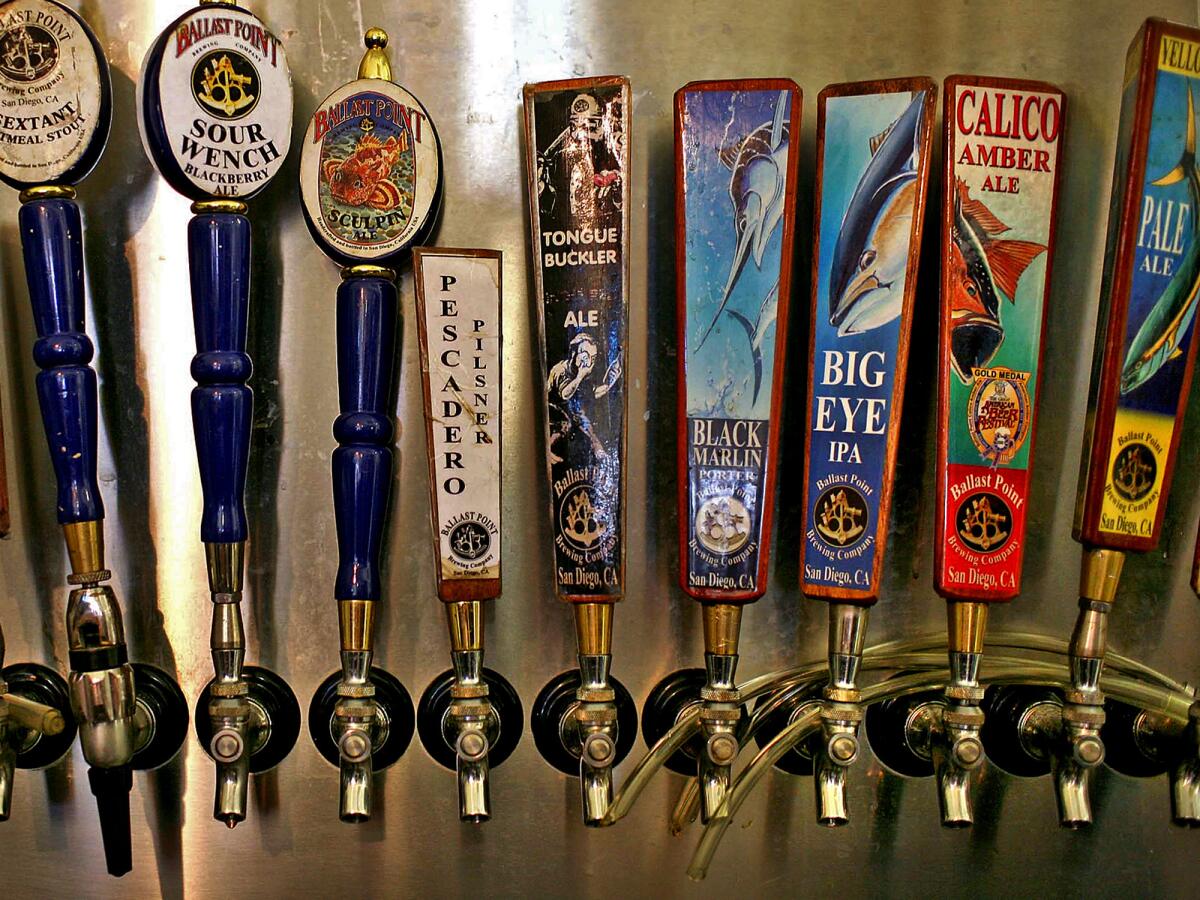Appeal of IPAs inspires Ballast Point IPO

San Diego-based Ballast Point Brewing Co. had filed plans with the Securities and Exchange Commission to go public.
Ballast Point Brewing & Spirits Inc. won over California beer aficionados with its Sculpin India pale ale, and now the San Diego craft brewer is betting that an even wider audience will want to try its hoppy beer.
The 19-year-old brewery has filed plans with the Securities and Exchange Commission to sell shares to the public and expects to raise $172.5 million. Ballast Point is just one of a few craft breweries — and the first in Southern California — to file for an initial public offering. The company plans to trade under the symbol PINT.
The move is the latest example of the booming popularity of craft beers, especially India pale ales.
Craft brews continue to outperform the overall U.S. beer market, where their market share has grown to 11% in 2014 from 4.9% in 2010. Retail sales of craft beer in 2014 totaled $19.6 billion, up from $8.8 billion in 2010, according to Ballast Point’s SEC filing.
California alone is home to nearly 600 craft breweries, the most of any state, according to the California Craft Brewers Assn.
Part of the appeal of craft breweries is Ballast Point’s specialty: India pale ales.
“As we’ve seen the craft beer trend really go upward, IPAs have really led the charge,” said Nick Petrillo, an analyst for IBISWorld. “They’re the complete antithesis of macro beer.”
American India pale ales, which became popular about a decade ago, have distinguished themselves from the standard English India pale ales with their wide range of aromatic hops and lots of bitterness but enough malt to balance it all out, he said.
Ballast Point produces more than 15 kinds of beer year-round, as well as seasonal beers and craft spirits, but the bulk of its sales comes from its Sculpin and Grapefruit Sculpin India pale ales. In its filing, the brewery said those beers probably will account for a large portion of revenues for the foreseeable future.
“Our future operating results, particularly in the near term, are significantly dependent upon the continued market acceptance of these products, and in consumer preference for” India pale ales, the brewery said in the filing.
Those India pale ales have propelled the brewery’s growth. In 2014, Ballast Point sold 122,890 barrels of beer, up from 37,161 in 2012, according to the SEC filing. Annual revenue totaled $48.9 million last year, compared with $14 million in 2012. Those numbers make Ballast Point one of the fastest growing breweries in California and possibly the nation, said Tom McCormick, executive director of the California Craft Brewers Assn.
The key, he said, has been its high-quality brews.
“They’ve done a good job of building brands that stand out,” said Bart Watson, chief economist for the Brewers Assn., a trade group for craft brewers. “It’s a very crowded IPA market right now, and they’ve managed to build a brand that still resonates with beer lovers.”
The brewery grew out of a San Diego home-brewing supply store called Home Brew Mart, which was founded in 1992 by Ballast Point founder Jack White.
White began home-brewing in his apartment at UCLA and found it difficult to get supplies. A “back room” brewery soon opened behind the store and by 1996, Ballast Point began making beer commercially.
The company also has a minority investment in a craft distiller called Ballast Point Spirits, which was founded in 2007 and produces small batches of vodka, rum, gin and bourbon.
Today, the company has four facilities in the San Diego area and distributes its beer in more than 30 states and 10 countries, according to the SEC filing.
The brewery said it would use the money raised by the IPO for “working capital and general corporate purposes,” though it said a portion of the funds could be used to acquire or invest in firms and products that “complement” its business.
Ballast Point is somewhat of a rarity in the craft brewing industry because many small brewers don’t generate the amount of revenue necessary to be a public company, Watson said.
An IPO can help a company raise funds quickly, but the downside of going public can be trickier for breweries.
Craft brewers often want to remain independent and keep control over their beer quality, which can clash with the revenue demands of a public company, Petrillo said. Ballast Point founder White seems to mitigate this by continuing to control a majority of the voting power of the company’s outstanding common stock after the IPO, according to the filing.
“I think a lot of brewers are very proud of their product, and they don’t want this conflict to begin at all,” he said. “When you go public, I think you invite that.”
More to Read
Inside the business of entertainment
The Wide Shot brings you news, analysis and insights on everything from streaming wars to production — and what it all means for the future.
You may occasionally receive promotional content from the Los Angeles Times.











